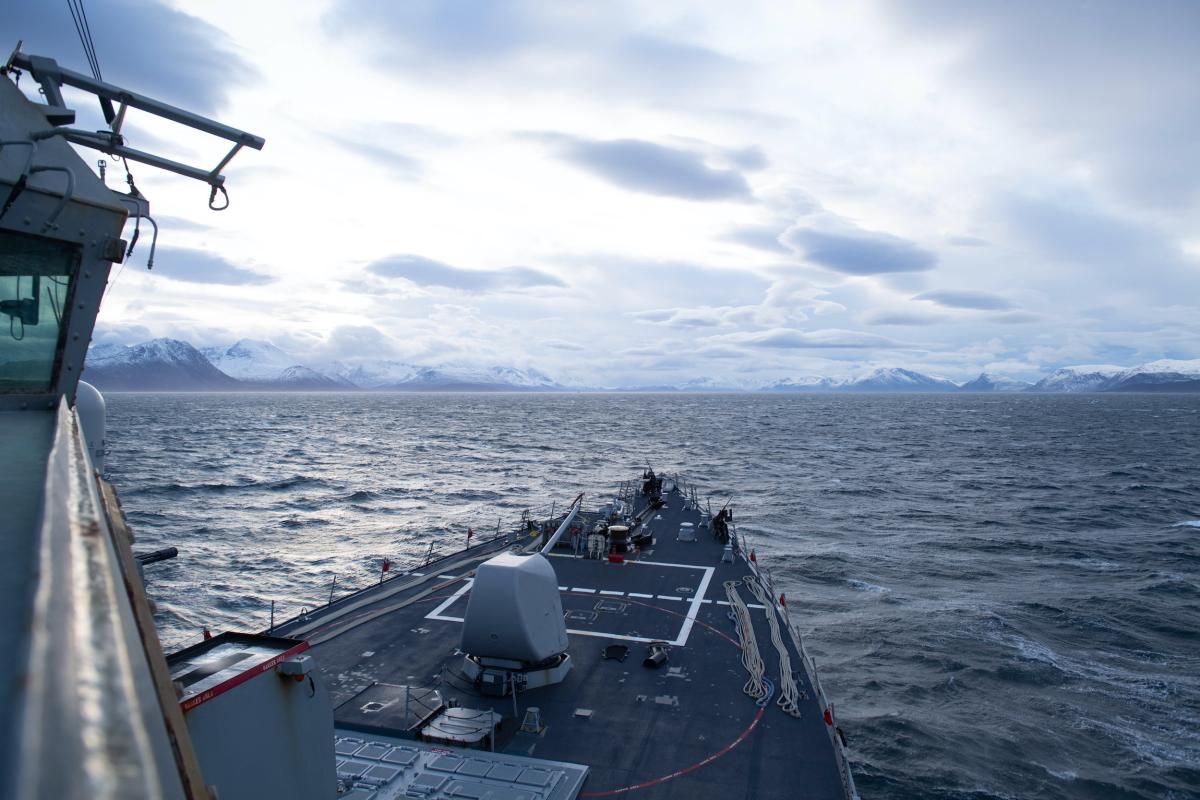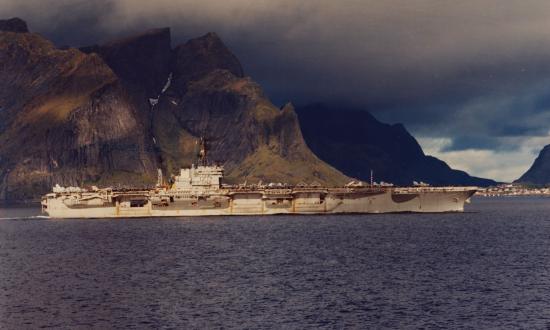The recent triservice maritime strategy Advantage at Sea is not an actual “strategy,” and this troubling reality is emblematic of the “strategic atrophy” identified by the 2018 National Defense Strategy. Advantage at Sea is more like a smorgasbord of operational ideas only loosely connected to a vague end state. Like many concepts proposed by the U.S. military, it lacks a coherent vision of how to connect ends, ways, and means. More specifically, its most resounding theme—all-domain maritime power—is an uncreative step backward, as other military services have been stressing the full integration of domains for the past five years.
Advantage at Sea’s embrace of multidomain operations in the maritime sphere is problematic because it largely excludes the Army and the Air Force, only briefly and vaguely referring at times to jointness. Some have argued that the Navy initially rejected multidomain operations because it already functioned in multiple domains. But the point of such operations is to bring capabilities from outside the maritime domain into it and vice versa, as needed. As such, a strategy focused on a single domain is counterproductive to jointness and to the Department of Defense’s (DoD’s) current direction. To resolve this and other flaws, the Sea Services must pursue an actual strategy to provide the core documents capable of enabling all military services to pursue a sound theory of victory, beyond merely outpacing Chinese technological development.
The Origins of Strategic Atrophy
The shortcomings of the most recent maritime strategy should come as no surprise given the Navy’s struggles to think strategically, but the Navy is not alone in this atrophy. Since the Vietnam War, the U.S. military has emphasized operational solutions that it hoped could win the next big war. Underpinning these operational approaches is the “continuous movement away from the political objectives of war toward a focus on killing and destroying things.”1 In other words, the U.S. military has not consistently adhered to Clausewitzian thinking regarding how to connect the use of force to achieving political objectives. Rather, it tends to pursue a narrower Jominian mind-set stressing the attainment of objectives on the battlefield.
Specifically, regarding the Navy, Peter Haynes has compellingly highlighted the institution’s strategic shortcomings in Toward a New Maritime Strategy, in which he demonstrates how the Navy has selectively adopted Mahanian thinking. Alfred Thayer Mahan created a maritime theory that incorporated aspects of naval combat, but the Navy has taken a narrower approach that stresses notions of decisive naval battle.2
This tendency can be seen in the 2018 Design for Maintaining Maritime Superiority 2.0’s mission statement (emphasis added):
The United States Navy will be ready to conduct prompt and sustained combat incident to operations at sea. Our Navy will protect America from attack, promote American prosperity, and preserve America’s strategic influence. U.S. naval operations—from the seafloor to space, from blue water to the littorals, and in the information domain—will deter aggression and enable resolution of crises on terms acceptable to the United States and our allies and partners. If deterrence fails, the Navy will conduct decisive combat operations to defeat any enemy.
This mission statement has sandwiched hints of a holistic naval strategy between “prompt and sustained combat” and “decisive combat operations.” Those operational and tactical tasks go last, not first and last. This approach reflects what Haynes has identified as the Navy’s tendency to reduce Mahanian theory to combat above all, and thus effectually reduce it to a naval rather than broader maritime strategy.
In this light, the Advantage at Sea might appear to begin the corrective swing back to a more holistic employment of power, but the strategy fails to offer a desired end state supported by adequate ways and means. This is not just the fault of the Navy. In many ways, the DoD lacks a coherent strategy because the 2018 National Defense Strategy simply reoriented the national security focus away from terrorism toward great power conflict without providing political objectives at which to take aim. No wonder, then, that the Navy—or any service—struggles to define effective long-term strategy.
Strategic Atrophy and the Rise of Multidomain Thinking
Sound theory is the starting point for successful strategy. As Milan Vego argues, military institutions require sound theory “for successful conduct of a future war,” in part because theory promotes balanced thinking along the “entire spectrum of warfare” that allows officers to pursue the widest range of options.
For the most part, the U.S. military has turned its back on ideas or sound theory as the bedrock of preparing for future warfare. Military culture tends to privilege tactical experience and notions of practicality over ideas, which seem more abstract to many officers. As a result, the military gives preference to technological innovation, reactively fixated on the notion that China has gained a technological advantage on the United States.
Indeed, this technological preoccupation sits at the heart of multidomain thinking. In 2018, for example, Army General Stephen J. Townsend explained that multidomain battle “stemm[ed] from the idea that disruptive technologies [would] change the character of warfare.” He further “recognize[d] that the way armies [would] fight and win wars [would] also change.” Of course technological change will affect future warfighting, but this observation is little more than a platitude. Problems occur when technology becomes the driving force of emphasis, thus throwing the theory of warfare into a neglected dustbin. Over the past century, for example, many navies have taken too “materialistic” of an approach to preparing for future warfare. They have sought technological solutions while neglecting theoretical soundness. As theory tends to be timeless, this is problematic, because military institutions emphasize change at the expense of continuity.
Technology and theory rest largely at the opposite ends of the spectrum of change and continuum. Theory should remind the military practitioner that there is not much new under the sun, as former Secretary of Defense James Mattis has pointed out.
When a military focuses primarily on the mostly changing aspects of future warfare—technology—it neglects that which offers wisdom into warfare’s strategic continuities that allow it to devise a sound theory of victory by connecting desired ends to ways and means.
Back to the Basics
There has been significant discussion of how to destroy the People’s Liberation Army Navy (PLAN), with some officials urging investment in maritime capabilities first and foremost. The Marine Corps, for example, has begun divesting itself of many traditional capabilities to ensure it can acquire rockets to help destroy the PLAN.
What is absent, though, is any theory of victory beyond the seeming assumption that the Chinese government will cease operations after it loses its navy. A related assumption centers on the idea that conflict could be limited to the maritime and air domains and perhaps even geographically to the South China Sea and/or Taiwan.
In this vein, Advantage at Sea claims as its starting point that the United States is a “maritime” nation. While it is correct that the seas help to provide the United States with “security” and “prosperity,” it is also true that the other domains of space, air, land, and cyber have an equally vital role in contributing to national security and affluence.
An additional problem with such labeling is the parochialism that emerges in portions of the maritime strategy. The strategy’s preface, for example, begins by emphasizing how the “combined Sea Services achieved victory in World War II” while omitting any mention of the Army and Army Air Forces (future Air Force), which strikes a highly antiproductive note in 2021.
The war in the Pacific against Japan was not solely a naval war, as the strategy’s rhetoric suggests. Rather, it was an air, land, and naval war. To argue otherwise is to implicitly push back against everything that multidomain warfare encompasses. Even the Navy’s official historian once observed that Guadalcanal’s importance owed much to the “variety and multiplicity of weapons employed and for coordination between sea power, ground power, and air power.” Similarly, strategist and naval officer J. C. Wylie argued that any strategy that broke strategy into domain-specific strategies should be considered artificial.3
More recent works such as Fire on the Water illuminate how maritime power rests as much on land-based capabilities as it does on sea-based capabilities.4 This reality, however, tends to be ignored whenever parochial tendencies appear as services anticipate more austere budgets. As one commentator has admitted recently, the “only realistic billpayer” for the Navy’s growth is the “service with the least skin in the counter-China game . . .: the U.S. Army,” which it posits must stay a “supporting service in such a fight.” In a similar vein, the maritime strategy trumpets the Navy’s “unique attributes,” thereby sounding more like playing service parochialism than providing a roadmap for embracing multidomain thinking. There is no room for “supporting” versus “supported” arguments in preparing for a potential peer fight.
Some members of other services have taken a broader view past the maritime domain in envisioning such a conflict. Interestingly, a retired Air Force officer, for example, has made a compelling argument for why land power need not be limited to a supporting role in the South China Sea, instead potentially playing a vital role in helping to secure sea control.
Advantage at Sea only vaguely acknowledges this, stressing how the Navy, Marine Corps, and Coast Guard have roles in “power projection,” while providing no further details as to what this power projection enables. Discussions of sea control also lack real multidomain thinking by omitting the Air Force and the Army from discussion by name, unlike the traditional Sea Services. One portion of the maritime strategy, for example, explains that the “Naval Services” themselves will “establish, maintain, and exploit sea control.” But other naval thinkers have more forthrightly acknowledged that in most cases the “exploitation of the control of the sea” aids in the “establishment of control on the land.” In other words, sea power—like air power—is more of an enabler of action on land than an end in itself.5
While many scenarios focus on a clash in the South China Sea, it would be difficult for a conflict to remain limited to the maritime domain, much less geographically. It is also unlikely the United States could win largely by destroying an opponent’s navy, as an opponent’s leaders must decide the point that changes the decision-making calculus.
This is the point at which strategy emerges. First, one must determine what the enemy most values to affect the greatest target of all: the enemy’s will. One may focus on destroying an enemy’s means to affect its will, or one may seek to attack the will itself. And, of course, one may strategize to attack both the means and will of an adversary simultaneously.
But this theory of victory is missing from the maritime strategy, which takes a Mahanian tone to suggest that operational concepts can be cobbled together to ensure that U.S. forces may “mass combat power at times and places of our choosing.” To what end or how this may change an opponent’s decision making is left unexplained. The absence of this key causal mechanism today replicates previous proposed operational solutions, such as air-sea battle.
Wylie and a Sounder Naval Theory
Seeking to justify funding for the Navy in the parsimonious environment of the post–World War II environment, J. C. Wylie found himself pursuing theory. In seeking to derive an effective solution for the Navy, he sought a holistic, all-encompassing theory of victory. He insisted that sea power could only be an end to ensuring “control over the land.”6 He also argued that naval strategy tended to be cumulative in that it constituted hard-to-see “minute accumulations” of progress, noting that cumulative strategies rarely worked on their own.7 He posited that the correct balance between sequential strategies—geographical, most easily measured by progress on land, and cumulative (typically air- and sea-based)—determined success.8 Naval strategists must think more deeply about the warnings and insights Wylie offered and how they might apply to a potential conflict with China, especially regarding the PLAN.
Advantage at Sea epitomizes how no service has yet escaped the strategic atrophy identified by the National Defense Strategy. Advantage suggests that the Navy has now embraced multidomain operations as its own primary domain. But, in an era of joint all-domain operations, a maritime strategy focused narrowly on the Navy, the Marine Corps, and the Coast Guard is incomplete at best.
Despite a lifetime of naval service, Wylie insisted that the “ultimate tool of control in war is the man on the scene with a gun.”9 The services must get back to the basics, eschewing the parochial elements in the latest strategy that exist in tension with the post-Goldwater-Nichols era. Until the Navy and the other services derive a sound, holistic theory of victory that can guide its key strategic documents, they will not escape the past decades of strategic atrophy.
- Frederick Kagan, Finding the Target (New York: Encounter Books, 2006), 358; J. C. Wylie, Military Strategy: A General Theory of Power Control (Annapolis, MD: Naval Institute Press, 2014; reprint, 1957), 181; Peter Haynes, Toward a New Maritime Strategy: American Naval Thinking in the Post-Cold War Era (Annapolis, MD: Naval Institute Press, 2015), 5.
- Haynes, Toward a New Maritime Strategy.
- Introduction in Wylie, Military Strategy, xxvi.
- Robert Haddick, Fire on the Water: China, America, and the Future of the Pacific (Annapolis, MD: Naval Institute Press, 2014), 274.
- Wylie, Military Strategy, 33.
- Introduction, Wylie, Military Strategy, xxvi.
- Wylie, Military Strategy, 24–25.
- Wylie, 26.
- Wylie, 74.





